Maple Gold Mines
Toronto Venture Exchange: MGM.V | US-OTC: MGMLF
Surrounded by Majors
& Advancing a District-Scale Gold Project in one
of the World’s Premier Mining Jurisdictions
The next stage of the gold bull market is emerging!
Goldman Sachs now sees gold reaching $1,800 an ounce in 2020 as a “haven of last resort” in the face of the coronavirus pandemic coupled with negative real rates and what’s being described as unlimited money printing or “quantitative easing” in the economic battle to stave off a depression.
As the 1-year gold chart (below) clearly demonstrates – a powerful bull market in gold is being established as investors move into gold and select gold stocks as a hedge against the devaluation of fiat currencies around the globe.
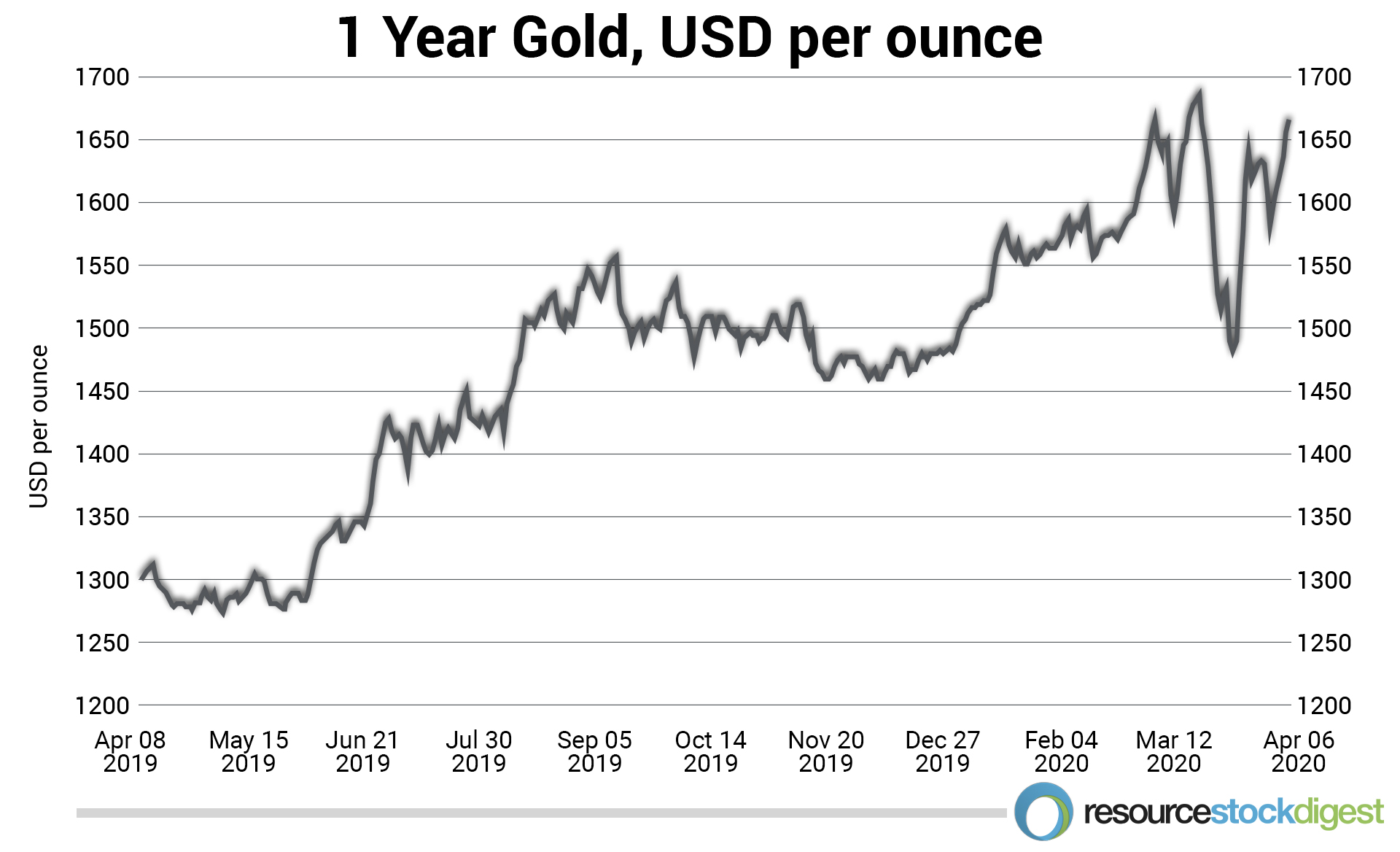
And that brings us to Maple Gold Mines Ltd.

Maple Gold is an exceptionally well-run, advanced-stage junior gold exploration firm operating in one of the most favorable mining jurisdictions in the world — Quebec, Canada.
Last year, the company announced an NI 43-101 resource of 2.77 million gold ounces (indicated + inferred) at its Douay Gold Project.
With a focus on resource expansion by way of the drill, the company was able to complete approximately 4,400 meters of its planned 7,000-9,000 meter winter 2020 drill program before temporarily stopping its rigs in accordance with orders from the Quebec Government pertaining to all non-essential businesses.
The bulk of assay results from the 2020 winter drill program are expected to be released during May and June of this year.
With approximately C$3 million in the treasury, Maple Gold is well-funded which means it will not have to go back to the market to raise additional funds this year — a huge plus in these uncertain economic times. And the company has been quick to enact company-wide fiscal measures of its own designed to preserve capital during the pandemic — including a 50% reduction in executive pay during Q2 2020.
I think that says a lot about the character of the Maple Gold team and their steadfast commitment to building value for MGM / MGMLF shareholders going forward.
Maple Gold Mines: At a Glance
- Trading at an optimal entry-point below US$0.10 per share
- Recently completed winter 2020 drill program with results due out soon
- Zeroing in on areas with higher-than-deposit-average grades, (e.g. from last year’s program: 16 meters at 4.58 grams per tonne gold at the 531 Zone)
- Systematically building gold ounces: already 422,000 oz indicated + 2.3M oz inferred
In a moment, you’ll be reading my exclusive interview with Maple Gold Mines’ president and CEO, Matthew Hornor. I found it to be a fascinating discussion.
But before we get to that… let’s take a quick look at the detailed property map (below) which shows the location of the Douay Gold Project and the bevy of mines that dot this golden landscape.
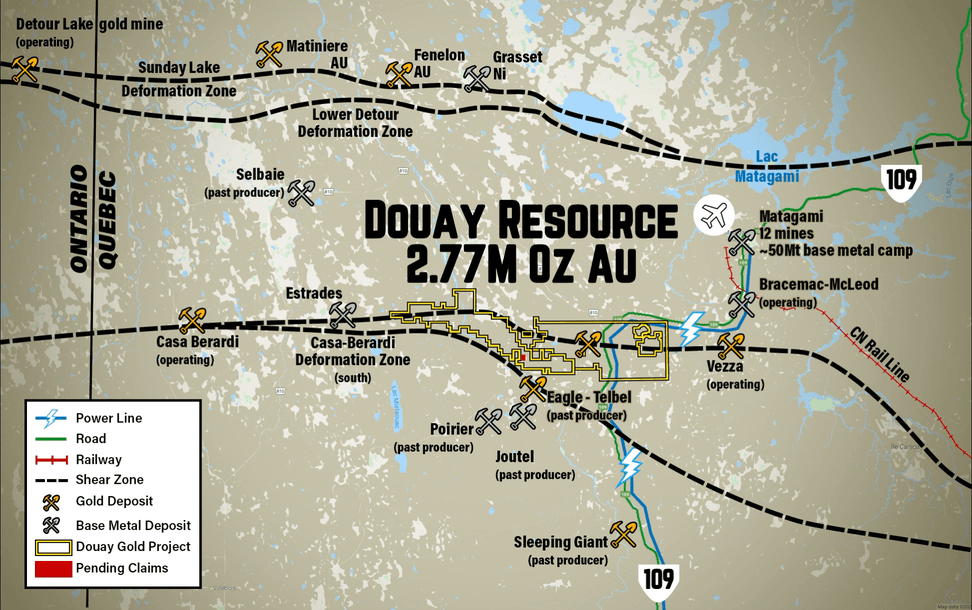
One thing you’ll notice right away is that Maple Gold Mines is literally surrounded by major gold production activity in the heart of the Casa-Berardi Deformation Zone.
The company’s property spans some 137 square miles (~350 sq km) including 34 miles (~55 km) of strike along the gold-bearing Casa-Berardi Break.
You’ll also note that the Douay property is near an airstrip, with power right to the site, and is situated right next to a main highway offering easy access to the project.
One thing you cannot tell from the property map is the vast amount of mining infrastructure that’s already on-site… and we’ll talk more about that later on in the report. Just keep in mind that location and infrastructure are vitally important to keeping exploration, drilling, and production costs in-check throughout the mine-development process.
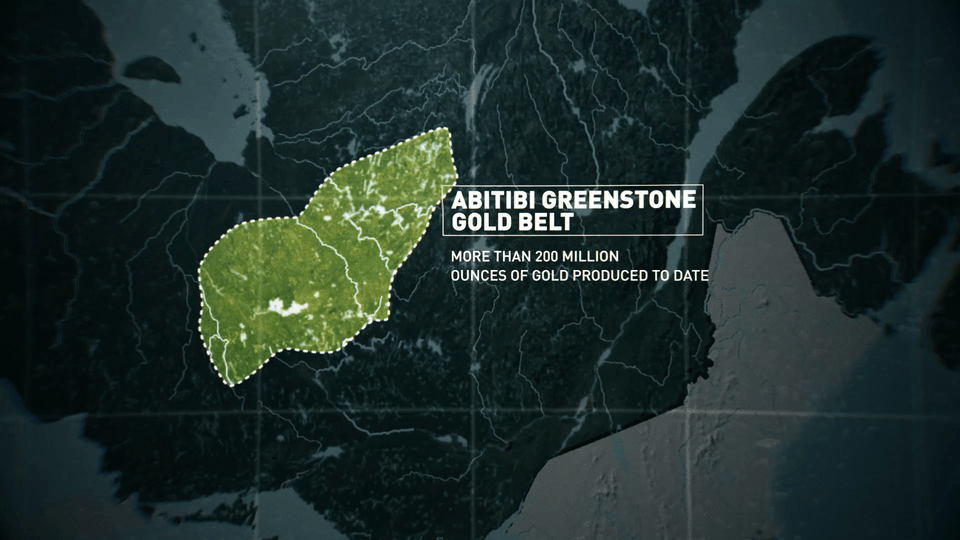
The Douay project area is situated within eastern Canada’s prolific Abitibi Greenstone Belt (AGB) which boasts past production of some 200 million gold ounces — making it one of the most productive gold jurisdictions on the planet.
This is true elephant country… we’re talking BIG gold deposits, including:
- Holt-McDermott: 1.3M+ Gold Ounces
- Beatty: 5.6M+ Gold Ounces
- Casa Berardi: 6.2M+ Gold Ounces
- Canadian Malartic: 12M+ Gold Ounces
- Detour Gold: 18M+ Gold Ounces
As mentioned, Maple Gold Mines has already confirmed an initial 2.77M oz gold resource (indicated + inferred) with an additional ~4,400 meters of drilling just completed that could expand that resource.
Targeted Drilling: Focused on higher-grade extensions
In 2018-19, Maple Gold’s geologic team developed a new 3D geological, structural, and mineralization model for the deposit.
The new 3D model is (1.) providing the company’s field team with a better understanding of the gold-bearing system at Douay, and (2.) is being deployed in the delineation of drill-targets.
And the early proof is in the numbers!
While the company drilled just a single hole at the 531 Zone in 2019 (guided by its new 3D model) – that hole produced some very impressive intercepts including:
- 51 meters @ 2.88 grams per tonne gold: including 16 meters @ 4.58 grams per tonne gold and 9 meters @ 4.92 grams per tonne gold
- 28 meters @ 2.55 grams per tonne gold: including 9 meters @ 4.71 grams per tonne gold
The 531 Zone represents a very intriguing opportunity for the company given the higher grades and lack of historical drilling in the area. With those impressive results in-hand, the company is now applying its newly-updated 3D data to its drilling and resource expansion activities across the Douay Project.
That includes a deepening of last year’s drill hole at the 531 Zone as part of the company’s recently completed 2020 winter drill program. That hole intersected 5.96 grams per tonne gold over 3.5 meters, including 11.35 grams per tonne gold over 1.7 meters from approximately 460 meters vertical depth.
March 16, 2020
Maple Gold’s Vice-President of Exploration,
Fred Speidel, commented:
“The deepening of DO-19-262 intersected an additional narrow mineralized zone with higher grades (greater than three times) than the current average for underground resources at Douay (RPA 2019) and the IP results we've received are very compelling in terms of there being a more extensive sulphide body at the 531 zone than has currently been drill tested. In addition, the IP survey results indicate that there may be an additional undrilled sulphide body to the west-northwest of the Main zone. The scale of these targets and general lack of drilling within these areas provide us with significant untested exploration upside.”
Momentum is now building as Maple Gold continues to generate brand new discovery targets across its greater property package.
One example is the North IP target where geophysical results from 2019 defined a 3 km long chargeability anomaly that prompted the company to complete infill IP (Induced Polarization) this winter to help vector in towards a new gold discovery.
Results from the recent IP work were just released (see April 8 press release).
This new target-of-interest is particularly compelling given the target has numerous similarities to the recently closed Vezza-mine, which hosted approximately 500,000 ounces gold at approximately 6 grams per tonne gold.
Given the scale of the chargeability anomalies, the Maple Gold team believes there is potential to add another Vezza-style gold lense or two if drilling is successful… something that would clearly generate a lot of excitement!
Exclusive Interview with Maple Gold Mines’
President & CEO, Matthew Hornor


president & CEO,
Maple Gold Mines
I had the opportunity recently to sit down with Maple Gold Mines’ president and CEO, Matthew Hornor. Matthew is a highly-adept mining executive with invaluable hands-on experience working with one of the industry’s most well-known company builders, Robert Friedland.
Mr. Hornor previously served as vice president and executive vice president for Ivanhoe Mines for 10+ years where he negotiated equity capital raises totaling more than $450 million. He’s built a top-notch team at Maple Gold Mines.
Please enjoy the interview…
Mike Fagan: Matthew, it’s great to catch up with you today. We have lots to get to including the recently completed drill program...
But let’s take a brief step backward, if you will, and talk about the history of the Douay Gold Project – which I believe was initially discovered by Inco Ltd. back in 1976. Can you start by describing the exploration history of that property before the turn of the century?
Matthew Hornor: Sure, Mike… and happy to be with you as well. So, Inco drilled a number of holes including a high-grade discovery intercept east of the highway back in 1976. While the grades were compelling, the amount of contained gold in that target area appeared limited… so Inco optioned the property to a junior company called Vior.
A local Quebec explorer drilled significant meterage [almost 100,000 meters] during the late-80’s and early-90’s discovering the Douay West and 531 Zones which are located approximately 4-5 km apart. The Douay West Zone was already compelling enough in the 90’s to attract Aurizon, who signed an option agreement that required them to bring the Douay West Zone into production as part of the earn-in agreement.
They drilled 11 holes and built mining infrastructure, but ultimately had to relinquish the option without ever producing an ounce due to corporate capital constraints and a low gold price environment [~$260/ounce].
MF: Jumping forward a bit, with the gold market showing signs of life in the early 2000’s, what additional exploration and drilling was completed before Maple Gold [formerly Aurvista] acquired the project in 2011?
MH: So, Vior completed an additional 30,000 meters of drilling and discovered what we now refer to as the Porphyry Zone, which is a 3+ km long zone of gold mineralization that essentially links up the western Douay West Zone at one end to the 531 Zone at the southeastern edge of the deposit.
The larger tonnage Porphyry Zone and the potential for continued exploration and drilling to link up other known zones and define new ones within the greater resource area changed the outlook for this project from one with prospects for smaller higher grade underground mining to one with significant bulk tonnage open-pit potential as well.
Unfortunately, the gold market pulled back significantly shortly after Aurvista acquired the project back in 2011, and so Douay was once again orphaned for a number of years during what proved to be a challenging period for the junior gold sector.
MF: Matthew, I imagine things didn’t change much until the beginning of the gold market’s most recent and current resurgence starting in 2016?
MH: Yep, exactly, Mike. The gold market began showing signs of life again, and a team of us were hunting for overlooked/undervalued/unloved gold deposits with the potential to provide significant returns in an improving gold market.
There were a number of attributes that attracted us to Douay:
First, the project benefits from a significant amount of historical investment. For example, just to drill all of the meters that have been completed to-date would cost around C$60 million today… let alone the time required for such an undertaking.
Second, all of the drill core from the programs dating back to 1976 are still preserved and meticulously archived at the site (see below). As you know, this is extremely rare and very beneficial for new geologists attempting to apply modern techniques to better understand the controls on gold mineralization.

And finally… location, location, location!
Douay is located within the Abitibi Greenstone Gold Belt — a belt that has seen more than 200 million ounces of gold produced to-date. That rich history is part of the reason the project has such excellent infrastructure, pro-mining communities, and skilled local labor.
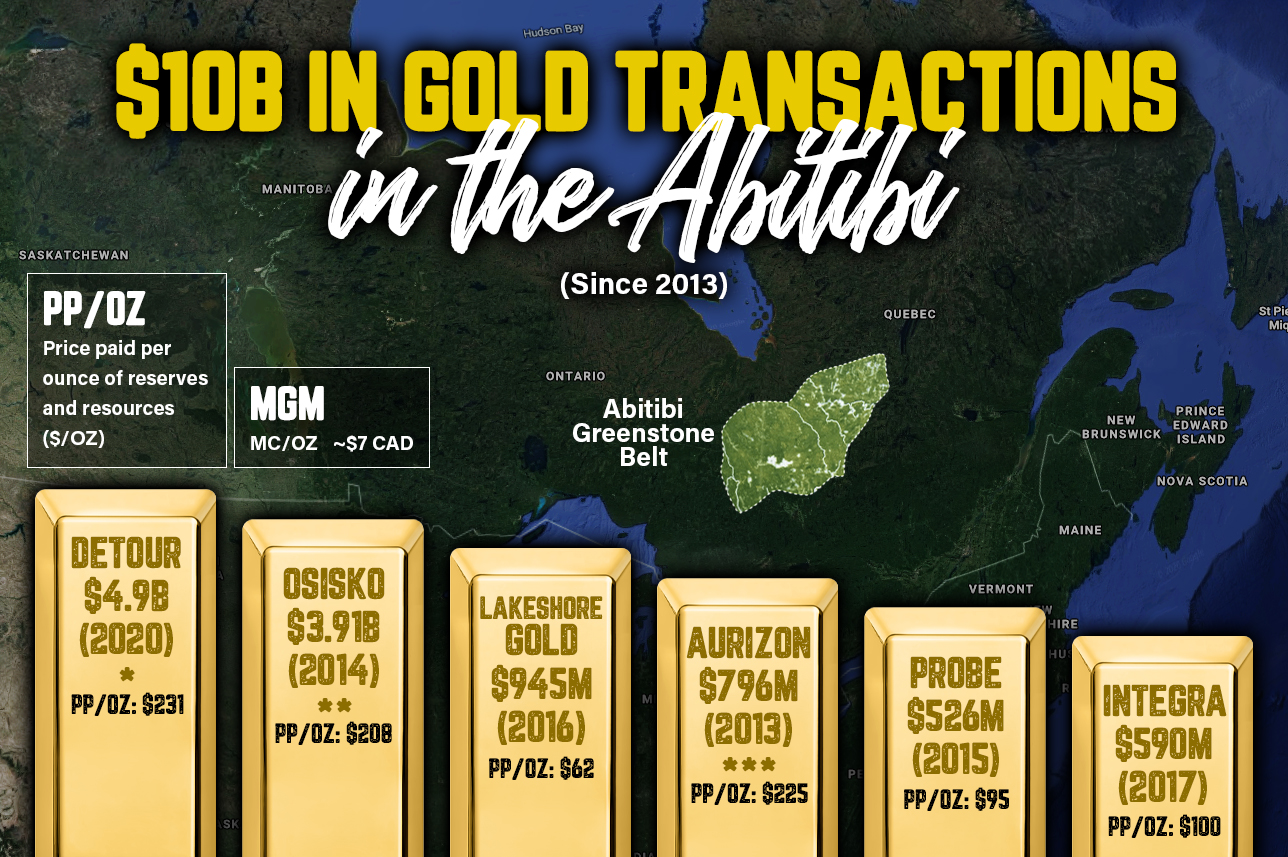
**Most similar geologically to Maple Gold’s Douay Gold Project (located 150km south of Douay)
***Located only ~ 50km west of Maple Gold’s Douay Gold Project along the same Casa Berardi Deformation Zone
All transaction amounts reported in Canadian dollars. (FX used for converting USD transactions: $1USD = $1.21CAD)
A lot of your readers probably already know this but Quebec is ranked as the 4th best mining jurisdiction on the planet with tax incentives and government supported financing alternatives.
That makes Quebec one of the best places to explore and most preferred destinations for gold producers to transact when they want to add ounces to their pipelines.
MF: Without a doubt. And by the way, this is true elephant country in terms of the size and grade of the numerous gold deposits that make up the greater Abitibi Greenstone Belt area play.
Can you give my readers the 411 on this expansive geologic formation as well as some of the larger gold deposits that surround the Douay Gold Project?
MH: Yeah. The Abitibi Greenstone Belt stretches across the Ontario/Quebec provincial border with numerous prolific faults with more than 200 million ounces of historic production. The mines within this region have contributed significantly to the local economies and have created significant wealth for several generations.
The deposit/mine that exhibits the most similarities geologically to Douay is the Canadian Malartic Mine (see below) which is located approximately 150 km due south with more than 12 million ounces of past production + current reserves/resources.
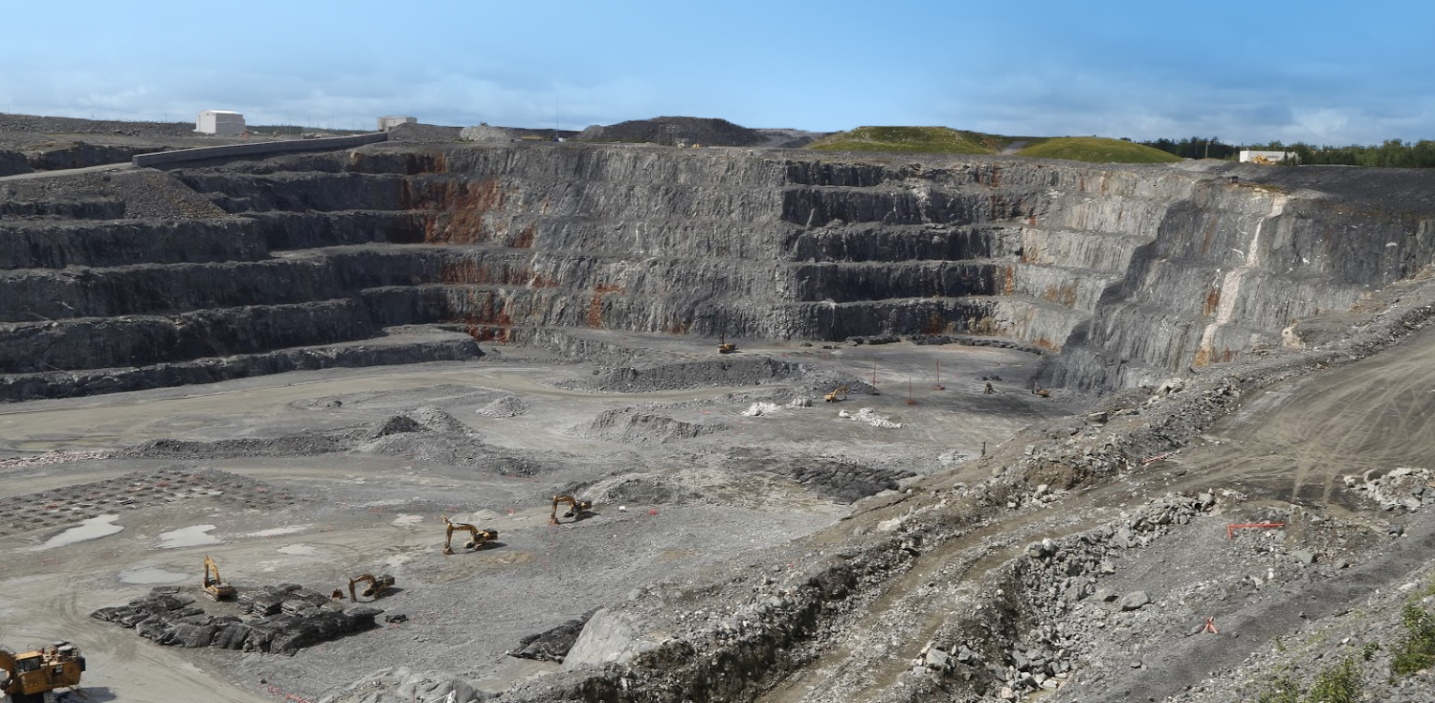
Osisko brought new ideas and started drilling and exploring around known resources there back in 2004 when they had a $10-20 million dollar valuation [market capitalization].
In 2014, and shortly after commencing production, Osisko sold the mine to Agnico Eagle and Yamana for $3.9 billion.
More recently [Jan 31 2020], Kirkland Lake closed their acquisition of Detour Gold, which boasts more than 18 million ounces of gold [past production + current reserves and resources] located 125 km to the northwest of Douay.
Kirkland paid $4.9 billion!
Closer to home, along the same Casa Berardi deformation zone that hosts the Douay Project, Aurizon sold its Casa Berardi gold mine [about 40 km to the west of Douay’s property boundary] for $794 million back in 2013.
Several other gold deposits in the region have sold for hundreds of millions of dollars before commencing production over the past 5-6 years. We believe Maple Gold’s Douay Gold Project has that same type of potential.
MF: Matthew, Maple Gold’s current valuation is sitting around $15 million in Canadian dollars and would appear to make investing in this company quite the compelling speculation.
What are you seeing in terms of some of the near-term catalysts to unlocking bigger value for the company and its shareholders?
MH: Aside from a brief false start in 2016, Mike, the junior gold sector has faced challenging market conditions for the better part of a decade. Advanced exploration companies with resource-stage projects like Maple Gold typically don’t see quantum leaps in valuation until the majors and mid-tiers rise.
After that is the point where the trickle down or waterfall effect begins with the smaller cap names experiencing strong breakouts as speculative capital begins entering the space at a faster clip.
Gold is breaking out, as you know, and last year we experienced the biggest year in terms of M&A dollar value on record in Canada [more than $30 billion].
The combined transaction value from last year was largely attributed to a few select major combinations – but I expect the volume of M&A transactions to increase in 2020 with more resource and development stage companies combining.
The amount of money spent on exploration over the past 8 years dried up significantly creating a great opportunity for companies like Maple Gold who control established gold resources in great jurisdictions with the potential for growth.
We are very well-positioned as other producers begin hunting downstream for additional ounces to fill their pipelines.
MF: And you can only control what you can control, right?
MH: Yeah, you know, we can’t control the market of course. None of us saw the COVID-19 situation escalating to the degree that it has, for example, but we’ve responded in order to ensure the health and safety of our employees and contractors and to preserve financial flexibility.
Our executive and exploration teams are working for reduced pay during Q2 yet remain working full-time as we are all committed to this. I believe there are several macro factors pointing to a very strong gold market in the near term, and the adjustments we are making simply put us in a better position to create value once the market stabilizes.
We remain focused on optimizing existing resources/models and the pursuit of defining new ounces that have the potential to deliver the greatest impact for the Douay deposit and future economic studies.
MF: And tell me about the potential catalysts from your winter drill program?
MH: So, we’ve completed about 4,400 meters of drilling to-date in 2020, and we hope to have new assay results out to the market later this spring.
We also have a very active data room with several notable major/mid-tier companies evaluating the project now that we’ve completed significant technical work since our team took over.
Delivering a new strategic partner in 2020 is a key focus for us and something that would bring immediate validation and credibility and support a rerating for the share price.
We believe the potential for making new discoveries at Douay is high, and every drill hole provides a potential catalyst for significant value creation.
MF: Yeah, you’re right at that exciting stage where a set of positive drill results can create so much momentum on all fronts. Matthew, we touched briefly on the benefits of mining in Quebec.
What are some of those key benefits, and what has the permitting process at Douay been like so far?
MH: Amazingly, Mike, the only permits we require for our exploration and drilling programs are forestry intervention permits. These permits take only a month or two to obtain and aren’t permits for the drilling itself but rather are for the brush clearing that’s oftentimes required in order to set up the drill pads.
I can’t say enough about the benefits of working in Quebec. For starters, mother nature has gifted this province with world class gold deposits which in-turn have attracted major mining companies from all over the world. Having your prospective buyers/customers operating next door is clearly a major benefit.
Quebec also has countless government funded/supported resource funds, tax benefits, and other initiatives that drive new exploration investment into the province. For example, the various tax incentives in Quebec result in Maple Gold receiving up to $0.38 back for every $1 the company invests into qualified exploration expenditures.
It’s a province with a rich mining history, which is the reason we benefit from skilled labor, established infrastructure, and communities that support exploration and mining activity.
When you land at the Val-d’Or [translation: Valley of Gold] airport, which is approximately a 2-hour drive south of our property – you’re greeted by advertisements for companies selling mining equipment and drill contractor services. Twenty minutes from the airport, you can peer into one of Canada’s largest open pit mines [Canadian Malartic] from a designated lookout.
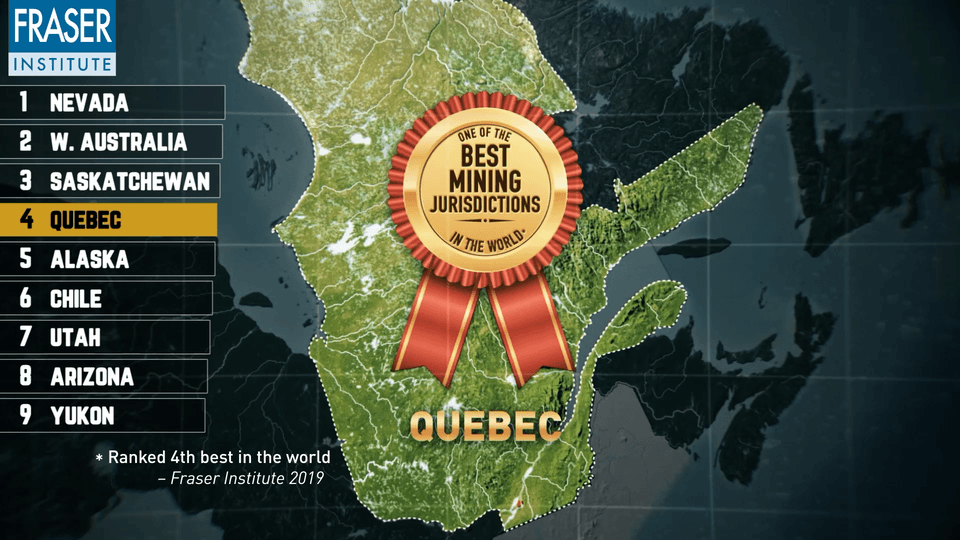
The Fraser Institute ranks Quebec as the 4th best mining jurisdiction on the planet… but I’d argue it’s the best in the world.
MF: Matthew, I’ve always said that having the right people at the controls is critical to the success of any junior resource firm. I’m impressed with the team you’ve put together.
Would you mind telling my readers a little bit about your background as well as that of some of the company’s key personnel?
MH: Sure, Mike. As a corporate finance lawyer by background, I started my career in Tokyo working with multinational conglomerates to finance and build projects worldwide.
I cut my teeth in the mining industry in 2005 when I began working for Robert Friedland when the Ivanhoe team was looking to develop what was then a late-stage exploration/development project known as Oyu Tolgoi. That project is located in Mongolia and boasts an incredible resource endowment and has now become one of the largest poly-metallic projects in the world.
After RIO Tinto bought control of that project, we went on to work in Africa as I began working at the senior executive level financing and operating large-scale mining projects.
When I learned of the Douay Gold Project, it very much reminded me of the elephant country and elephant hunting we were doing at Ivanhoe – except for one main point: Douay is located in one of the best mining jurisdictions anywhere as opposed to some of the more challenging environments we were used to [Mongolia, SA, DRC, etc].
When I joined MGM as CEO, I invited some of my colleagues to join the effort including Dr. David Broughton [a Lindsay Thayer award winning exploration geologist] and the one responsible for Ivanhoe’s discoveries at Platreef and Kamoa. David and I then together brought in our VP Exploration, Fred Speidel, who hails from Quebec and who started his career hunting for gold there, as did David beginning in the early 90’s.
Our Executive Vice-President, Joness Lang, and CFO, Gregg Orr, round out our executive group and bring significant capital markets and finance experience to the team.
MF: Excellent. So let’s delve into this year’s drilling a bit more. I know part of this is an extension of the impressive gold intercepts you recorded from last year’s drill program.
What’s happening on the ground now?
MH: Mike, we drilled approximately 4,400 meters this winter. Given the COVID-19 pandemic, we did not ramp up with additional drill-rigs to reach our initially planned 7,000-9,000 meter program. This was done to ensure the safety and health of our employees and contractors and also to conserve capital and ensure financial flexibility given the uncertainty in the market.
We completed drill-holes at the 531, NW, Nika, and Porphyry Zones. Last year, we had a tremendous drill result from the only hole we drilled at the 531 Zone [51m @ 2.88 g/t Au and 28m @ 2.55 g/t Au].
This year, we deepeed that drill-hole to see if any additional higher grade might exist at further depth. We cut 3.5 meters @ 5.96 g/t Au (including 11.35 g/t Au over 1.7 meters) further down-hole. Given the very favorable IP results we just obtained from our geophysical survey this winter, returning to drill additional holes at the 531 Zone is certainly a priority going forward.
Keep in mind that there had been no drilling at the 531 Zone in almost 7 years and no significant drilling at this zone since the early 1990’s.
The IP results at the 531 Zone are compelling in that they appear to support the company's east-southeast (largely undrilled) trend for sulphide mineralization associated with higher-grade gold in the currently drilled area.
We were confident the IP would support our interpretation of the zone being open for between 350 to 1,000 meters to the east/southeast, which it did, but the results also indicate this zone is wide open to the W/NW as well.
On February 24th, we announced that our drill rig had shifted to the NW Zone — an area that, not unlike the 531 Zone, has seen very limited drilling over recent years. Our technical team identified a potential western extension of known higher grade (3.14 g/t Au over 8.9 meters) that starts near-surface.
So, just like last year at the 531 Zone, we drilled a single hole here at the NW Zone to test an intriguing concept.
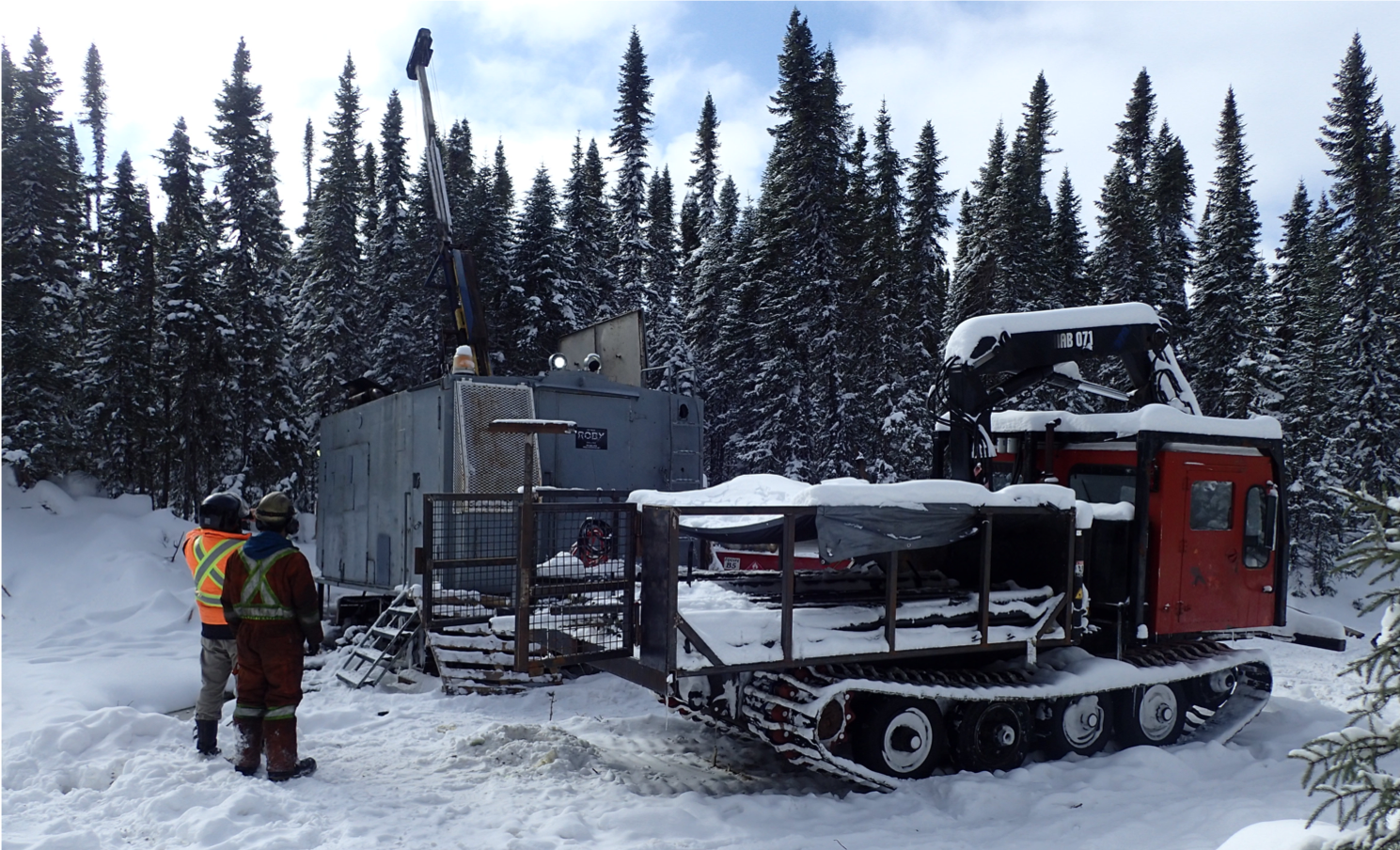
Beyond that, we’ve drilled a series of holes in the Porphyry and Nika Zones within the known deposit area. These holes are primarily focused on cutting higher-than-deposit-average grades within the top 200 meters from surface.
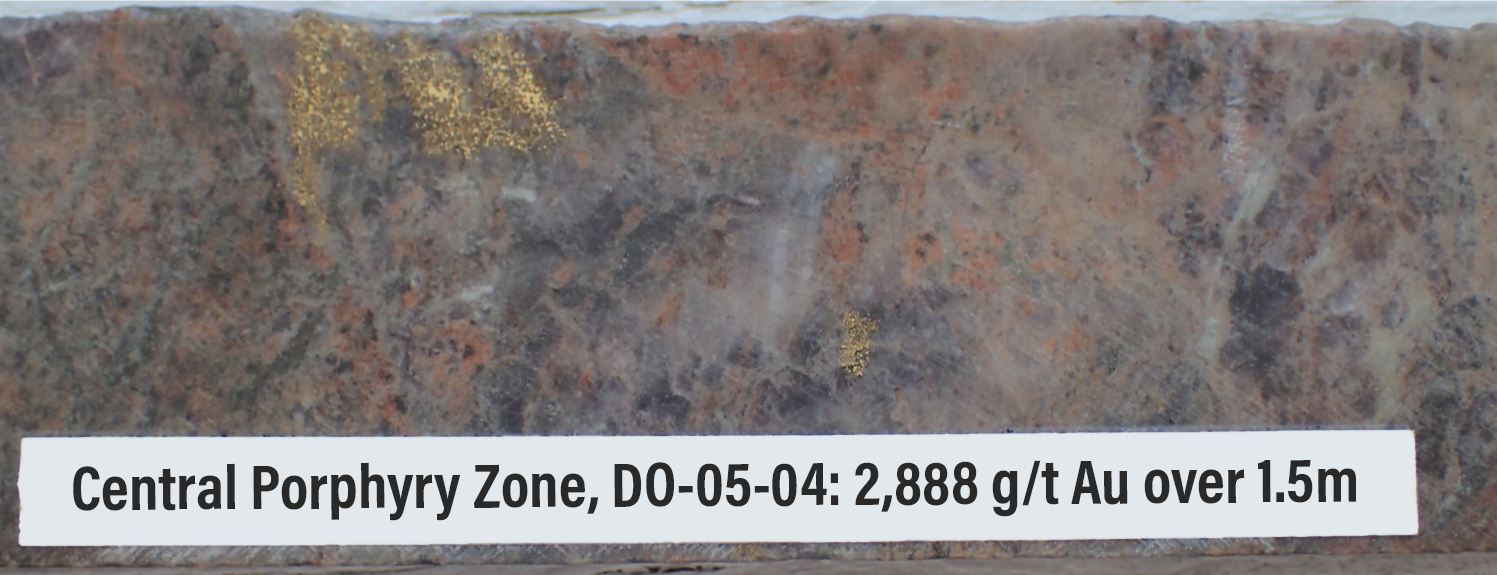
All of the drill core is being sawed and logged at site right now. I expect samples to be shipped to the labs in April and May, and investors can expect assay results from us during May and June this year assuming Ontario labs continue operating normally.
MF: I also understand the company is targeting additional high-grade discoveries on the Douay property based on results from last year’s IP (Induced Polarization) surveys.
What can you tell me about that process, and are the initial targets in close proximity to any of the known high-grade zones?
MH: Mike, as you know, I come from the Ivanhoe-world where our group was constantly challenged to generate new discovery targets with game-changing potential. We’re deploying that same approach here at the Douay Gold Project.
We will continue to drill compelling targets within the established resource area, but we’re also allocating 10-25% of our annual exploration budgets toward making brand new gold discoveries across our very large land package.
One of the areas we’re currently evaluating is located approximately 6 km [3.7 miles] to the northeast of the 531 Zone. We defined a 3 km long chargeability anomaly there last year and have just recently completed further IP work in this area to firm up drill targets.
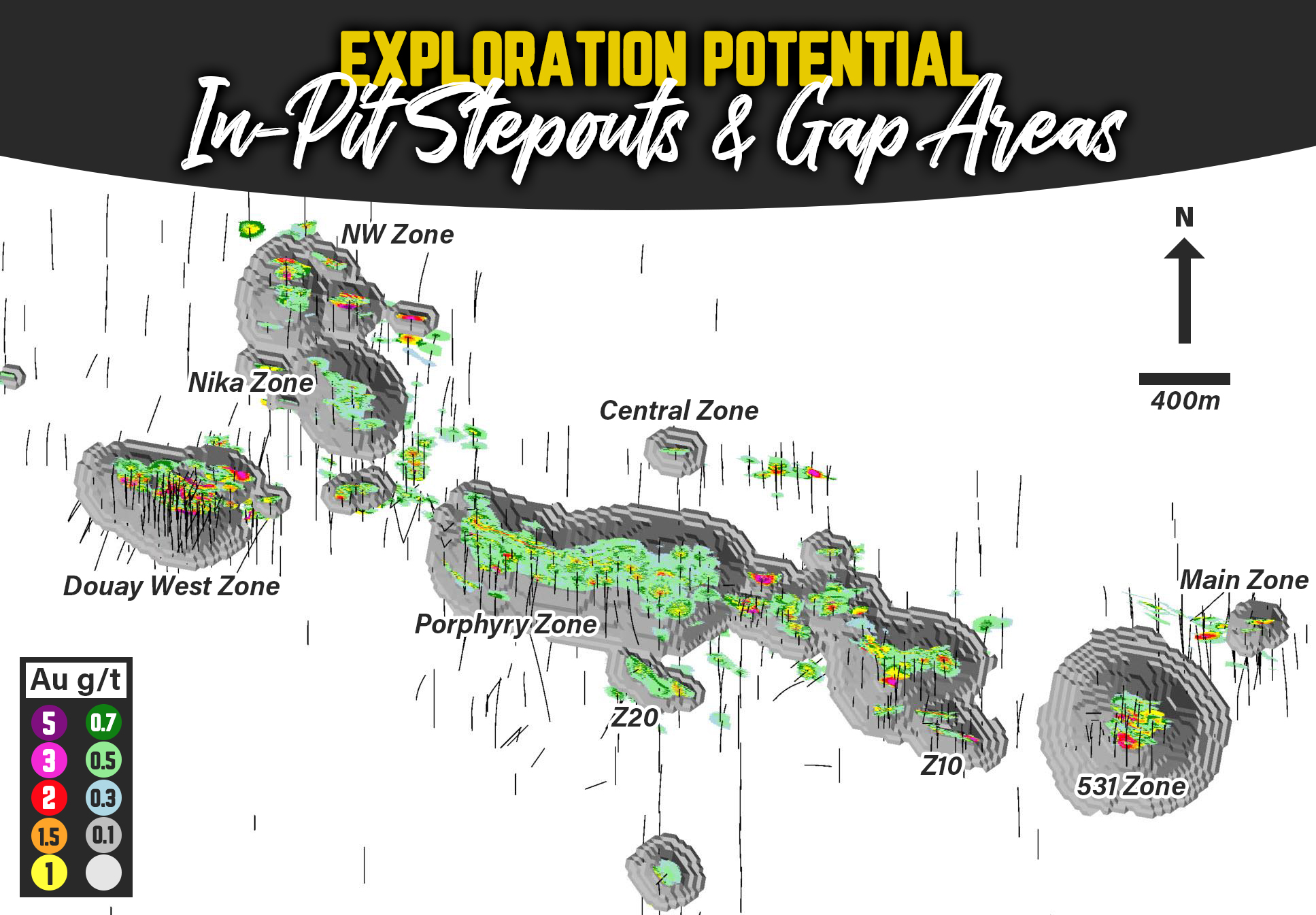
In fact, for your readers who are interested in learning more about that particular area-of-interest, they can check out our press release from April 8. We’ve identified a 1,500 meter long drill-ready target, and we should be able to get some scout-holes put in there, I’d say, within the next 6 to 12 months.
The target concept for this area is analogous to the Vezza Mine, which is located just 12 km to the east of our property and recently finished operating with approximately 500,000 ounces of gold at roughly 6 g/t Au produced life-of-mine.
New discovery drilling is higher risk with lower probabilities of success, but the prospect of adding one or two Vezza-type gold zones to our current resource base makes the potential reward well worth the risk.
MF: Yeah, that’s definitely the kind of high-grade material that’s worth chasing. So I think we sort of alluded to the fact that there is no shortage of majors involved in this broader area play.
With that being said, is the plan to sort of string together multiple high-grade discovery zones with the intent of drawing the attention of some of those larger players?
MH: Mike, the first phases of our plan were to bring the quality of the technical and modeling work to the same standard that one of those larger gold companies expects to see when evaluating a new opportunity.
I think it’s fair to say that we already have their attention. Our task now is demonstrating that our hard work and updated interpretations can lead to the discovery of additional higher-grade ounces to delineate as potential starter pits within the known resource area and beyond.
If we’re successful in doing that while defining a resource with strong economic viability — I’ve no doubt that the larger gold players will fight to gain control of the asset.
MF: Matthew, is the company fully-funded to complete its 2020 exploration and drilling program – or do you anticipate the need for an additional capital raise this year?
MH: We closed more than C$1,000,000 in funding at the end of last year that brought our treasury to slightly more than C$4,000,000 as of December 31, 2019. We also received a tax refund from Revenu Quebec of approximately C$400,000 in early March.
Mike… you asked about the benefits of working in Quebec — and there’s your prime example!
Working in a part of the world where the government puts money back in your jeans – as opposed to trying to take dollars away – is just one of the wonderful benefits we enjoy operating in Quebec.
With the capital mentioned above, we are fully funded to execute our current drilling and exploration plans this year and will determine timing for a next financing based on exploration results and market conditions going forward.
MF: Matthew, it’s obviously been a bit of a rough ride in terms of the company’s share price performance over the last few quarters. To me, the market seems to be sleeping on a lot of the higher-quality juniors.
What’s your take on that – and can you talk a little bit about Maple Gold Mines from a value perspective?
MH: Yeah, it has been a challenging market for juniors to gain traction and build momentum – and it’s been that way for the better part of a decade. Many resource specific funds have closed, and the brokerage industry has consolidated with fewer houses having the analytical expertise to pick individual gold stocks.
The proliferation of ETF’s has also provided another initial entry point for investors into the gold sector – and the general frustration with gold equities lagging the spot price before this recent COVID-19 pandemic has no doubt created deal fatigue for many that have entered the sector over the last 2 to 3 years.
From a value perspective, I think the fact that juniors like Maple Gold are still trading in the same range (or lower) as they have for the past year while the gold sector shows very strong signs of entering a sustained bull market run is what makes the investment opportunities in high-quality junior gold companies so unique and compelling right now.
MGM is trading at a valuation of roughly C$15M right now. To put that in perspective, and I think I mentioned this, the historical exploration and drilling investment at this project would cost around C$60M to complete in today’s dollars.
Another simplified metric one can consider is market capitalization per ounce of gold in the ground:
Maple Gold currently trades at approximately C$5 or C$6 per ounce. For context, the Casa Berardi Mine [40 km to the west] and the Canadian Malartic Mine [150 km to the south and closest geologically to Maple Gold’s Douay Project] were both acquired for more than $200 per ounce. Our current resource is largely (85%) inferred and these mines were in production when acquired, but these examples provide some context for where things could go with further exploration success.
Our team has put in an enormous amount of work to optimize the existing resource estimate and establish a quality foundation that included the re-logging of old drill core and bringing historical drill data into a modern 3D model.
This work took us time, and perhaps wasn’t that exciting for investors — but those hard yards are completed, and now we’re in position for further exploration and drilling breakthroughs.
New drilling or resource modeling successes all have the potential to significantly impact and improve our per ounce valuation… not to mention a higher gold price. So there are several ways to create shareholder value as we advance and de-risk the Douay Gold Project going forward.
MF: Wrapping things up, Matthew, what can Maple Gold shareholders expect in terms of news-flow over the next several months?
MH: Mike, as we discussed… investors can expect more exploration and drill results within the near-term, including follow-up data from our North IP target where we’re targeting new Vezza-type gold discoveries.
We’ll also have drill results from our winter campaign out to the market starting as early as late-April with final results expected to be released by June. Further drilling and exploration work may commence again later this year.
Lastly, we continue to forward different strategic alternatives, so there is potential for M&A or a new strategic investment from a mid-tier gold producer to happen later this year as well.
MF: Excellent, Matthew. Thank you so much for taking the time. We’ll be watching your company’s developments very closely. Be safe out there!
MH: It’s been my pleasure, Mike… you as well.
Next Drill Results could be a Game-Changer
There are a lot of eyes on Maple Gold as the company enters this crucial resource-expansion stage at its 100%-owned Douay Gold Project.
Keep in mind that this is a district-sale project spanning some 137 square miles (including 34 miles of strike along the gold-bearing Casa-Berardi Break) within eastern Canada’s prolific Abitibi Greenstone Belt — host to some 200 million-plus ounces of historic gold production.
As discussed, the company is systematically building gold ounces by way of the drill: already 422,000 oz indicated + 2.3M oz inferred.
The focus right now is on broadening the known resource base at Douay by identifying additional areas of near-surface, high-grade gold mineralization as potential starter pits. That includes recently completed drilling at:
- 531 Zone: 2 drill holes
- Nika Zone: 4 drill holes
- Northwest Zone: 1 drill hole
- Porphyry Zone: 7 drill holes
The bulk of those assay results (12 holes) are expected to be released within the next several weeks (May and June).
The strategy of focusing on near-surface, high-grade gold mineralization should translate to a number of potential advantages including reduced capital costs, a lower strip ratio, and a shorter payback period. And it should ultimately serve to substantially de-risk the project, which is a key metric many mid-tiers and majors look for in the acquisition evaluation process.
From a macro-perspective, I think what we’re going to see going forward is the industry placing a premium on gold exploration projects in safe mining jurisdictions that have proven ounces in the ground, areas of known high-grade mineralization, and, most importantly — scale and exploration upside.
Maple Gold Mines checks all of those boxes!
Plus, as noted, the company is well-funded with approximately C$3 million in the treasury and won’t need to go back to the market to raise additional funds this year even if market conditions remain weak. Maple Gold’s management team has significant financial connections as well with a demonstrable ability to raise capital.
That’s a huge bonus in these uncertain economic times.
With more than 4,000 meters of drilling just completed, the next set of positive assay results could mark the beginning of an extended rise in share value as the market digests the forthcoming drill data.
Right now is an opportune time to be looking at Maple Gold Mines Ltd. (TSX.V: MGM | US-OTC: MGMLF) as a timely investment opportunity in the junior gold sector. The company’s shares are currently trading below US$0.10 per share – and investors can reasonably expect a steady stream of news-flow over the next several months.
Yours In Profits,
Mike Fagan, Editor
Resource Stock Digest
Please note that the statements, opinions, estimates and forecasts regarding Maple Gold Mines set forth in the attached report are those of the author alone and do not represent statements, estimates, opinions or forecasts of Maple Gold Mines or its management. Maple Gold Mines does not, by its reference to this report or its distribution, imply its endorsement of, or concurrence with, such statements, estimates, opinions or forecasts. Investors should refer to Maple Gold’s continuous disclosure filings on sedar for up to date information about material matters relating to the company. The information presented in the report should in no way should be construed or interpreted as, or as a part of, an offering or solicitation of securities.